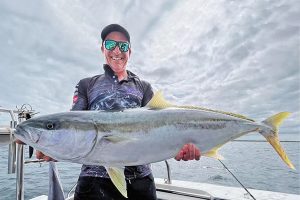
David Kramer of Cranbourne Fishing World with a kingfish that measured over a metre in length taken at Port Phillip Heads (Picture: Cranbourne Fishing World).
Port Phillip Heads
Kingfish have made a welcome re-appearance at Port Phillip Heads, and among those to catch them was David Kramer of Tackle World Cranbourne who took several – the biggest measuring over a metre in length – using freshly caught squid for bait.
They have also been a boon to charter boat operators, like Matt Cini of Reel Time Charters who found them for his clients, among them Duane Barton, who also caught one over a metre in length.
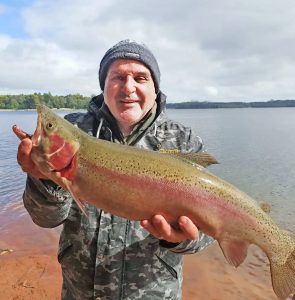
Nick Tamburro with the 65 cm rainbow trout he caught from the Moorabool Reservoir.
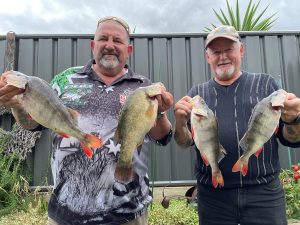
Kevin Wild and John Gray with a sample of their redfin and yellowbelly catch from Tullaroop Reservoir.
Corio Bay Bellarine Peninsula
On Sunday, Andrew Phillips, along with Mark and Tina Sesar were hoping the weather would ease, before heading out of Point Richards on the whiting, but that wasn’t to be the case. So, come early afternoon, they ventured out to one of their more productive spots off the east end of the mussel farm.
Initially, it was pretty tough going, but they got a few good fish in spite of the adverse conditions. However, a break in the weather from around 3.00 pm also heralded an improvement in the fishing, and by the time the tide had eased off toward evening, all three had taken their respective bag limits of whiting, the biggest of which measured 43 cm.
Paul and Selin Rahman had similar success on the whiting, taking bag limit catches off Curlewis a little earlier in the week. And, with time on their hands, they decided to head across the bay toward the Mountain View Quarries, hopeful of catching a snapper.
It wasn’t long before one of the rods buckled over to the yelp of the reel, but that was all. Whether it was a snapper or not is hard to say, but the next time it happened, it yielded a 7 kg gummy shark.
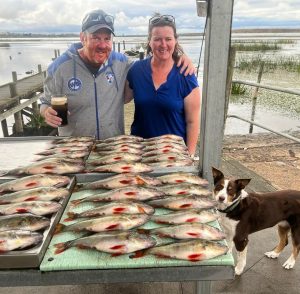
Jeremy and Michelle Richardson, and Missy, with their catch of redfin from Lake Purrumbete (Picture: John Clements).

Alex Toff (left) with son Elliot and their catch from Lake Purrumbete (Picture: John Clements).
Freshwater
I’ve only had the very occasional report from the Moorabool Reservoir at Bolwarrah since it was re-opened; I believe in 2012. That was after an extended closure by the Central Highlands Water Board who had simply padlocked all of the gates and erected threatening signage, as they allegedly had a predilection to do at other waters within their domain.
Moorabool Reservoir is just over 90 km north of Geelong along Spargo-Creek Road (off the Ballan/Daylesford Road, near Bungaree). And, last week, Nick Tamburro paid a visit tempting a 65 cm rainbow trout – which later weighed 2.8 kg after being cleaned – from the bank while soaking a scrubworm. So, it definitely could be worth a visit.
Kevin Wild of the Maryborough Angling Club reports that Tullaroop Reservoir is still fishing well, for redfin in particular which have responded to a variety of methods that have included jigging, and trolling, with Zerek fish-trap lures bringing home the goods.
Kevin fished here with club members Ken Hinks on one occasion, and with John Gray on another for a total catch of 67 redfin to 1.6 kg, and a yellowbelly of similar size.
Andrew Ketelaar scored both redfin and brown trout on Sunday from Wurdiboluc Reservoir, using soft plastics and Rapala Husky Jerk. bibbed lures. And, using the wind to his advantage toward evening, was able cast far enough to reach the strike zone around the weed beds. The redfin were up to 45 cm and the browns were in the 500 gram range.
John Clements of the Lake Purrumbete Holiday Park reports that the fishing is good with redfin the most sought-after fish, something to which Jeremy and Michelle Richardson of Colac could attest after making a bumper catch from 18 metres of water from the lake, along with dog Missy, last week.
Chinook salmon have also been on offer said John with Flynn Collins of Warrnambool picking up a nice one of 2.8 kg while bait fishing just above the bottom.
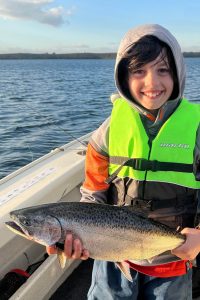
Flynn Collins with the 2.8 kg chinook salmon he caught from Lake Purrumbete (Picture: John Clements).
In memoriam: Terry Sheppard
As per the late Terry Sheppard’s wishes, there will be a gathering at Lake Purrumbete Holiday Park on Saturday May 7 next, at noon, for a BBQ lunch and the scattering of his ashes onto the lake.
To attend, RSVP Chris Farrugia on 0411 640 477 or John Clements on 0438 682 765, or by messenger, by Friday April 29 next.
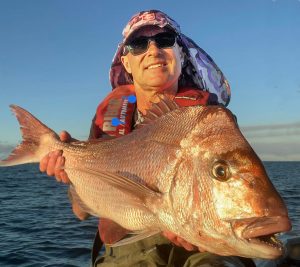
Damon Sherriff with an 83 cm snapper taken off Bridport in northern Tasmania.
Tassie Snapper
Damon Sherriff’s biggest snapper off Bridport in Tasmania last week measured 83 cm. And, like the others in a bag limit catch, mainly of fish from 3 to 4 kg, was taken on the heads, and fillets of fresh mullet.
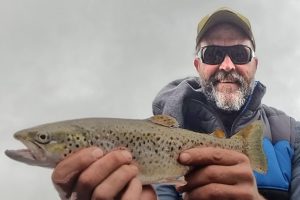
Andrew Ketelaar with one of his brown trout from Wurdiboluc Reservoir.
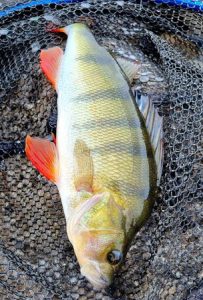
One of Andrew Ketelaar’s redfin from Wurdiboluc Reservoir.
Ollie asks:
Geoff, is there any difference between a stingray and a stingaree, or is the latter just slang?
Ollie, using the reference Sharks and Rays of Australia, by P.R. Last and J.D. Stevens as a guide – and leaving eagle rays out of the discussion – I can tell you that stingrays and stingarees have separate taxonomic classifications, the former being Dasyatidae and the latter Urolophidae.
The physical differences are that stingrays are generally larger, more rhomboidal in shape, and with usually longish, and – except for one or more barbed spines, and sometimes thorn-like denticles – unadorned tails.
Stingarees, on the other hand are smaller, usually more circular rather than rhomboidal in shape, with shorter tails – also equipped with barbed spines – but with characteristic leaf-shaped caudal or tail fins.
The smooth stingray, Dasyatis brevicaudata, is the largest of our local stingrays, sometimes exceeding a width of two metres. On the other hand, Urolophus gigas, or spotted stingaree is rarely more than 40 cm in width, and locally, is the most common in that classification
